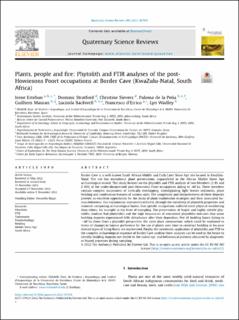| dc.contributor.author | Esteban, Irene | |
| dc.contributor.author | Stratford, Dominic | |
| dc.contributor.author | Sievers, Christine | |
| dc.contributor.author | Peña, Paloma de la | |
| dc.contributor.author | Mauran, Guilhem | |
| dc.contributor.author | Backwell, Lucinda | |
| dc.contributor.author | d'Errico, Francesco | |
| dc.contributor.author | Wadley, Lyn | |
| dc.date.accessioned | 2023-05-24T09:43:35Z | |
| dc.date.available | 2023-05-24T09:43:35Z | |
| dc.date.created | 2023-03-08T13:33:31Z | |
| dc.date.issued | 2023 | |
| dc.identifier.issn | 0277-3791 | |
| dc.identifier.uri | https://hdl.handle.net/11250/3068808 | |
| dc.description.abstract | Border Cave is a well-known South African Middle and Early Later Stone Age site located in KwaZulu-Natal. The site has exceptional plant preservation, unparalleled in the African Middle Stone Age archaeological record. This study focuses on the phytolith and FTIR analysis of two Members (2 BS and 2 WA) of the under-documented post-Howiesons Poort occupations dating to ∼60 ka. These members contain complex successions of vertically overlapping, interdigitating light brown sediments, plant bedding and combustion features of various sizes. The complexity and distinctiveness of these deposits provide an excellent opportunity for the study of plant exploitation strategies and their associated human behaviour. Our taphonomic assessment inferred, through the variability of phytolith properties and minerals composing archaeological layers, that specific occupations suffered more physical weathering than others, for example in the form of trampling. The preservation of fragile and highly soluble phytoliths (eudicot leaf phytoliths) and the high frequencies of articulated phytoliths indicates that some bedding deposits experienced little disturbance after their deposition. Not all bedding layers dating to ⁓60 ka show, from a phytolith perspective, the same plant composition, which could be explained in terms of changes in human preference for the use of plants over time to construct bedding or because distinct types of living floors are represented. Finally, the systematic application of phytoliths and FTIR to the complex archaeological sequence of Border Cave confirm these analyses can be used in the future to identify bedding deposits not visible to the naked eye, and behavioural patterns obscured by diagenetic or biased processes during sampling. | en_US |
| dc.language.iso | eng | en_US |
| dc.publisher | Elsevier | en_US |
| dc.rights | Attribution-NonCommercial-NoDerivatives 4.0 Internasjonal | * |
| dc.rights.uri | http://creativecommons.org/licenses/by-nc-nd/4.0/deed.no | * |
| dc.title | Plants, people and fire: Phytolith and FTIR analyses of the post-Howiesons Poort occupations at Border Cave (KwaZulu-Natal, South Africa) | en_US |
| dc.type | Journal article | en_US |
| dc.type | Peer reviewed | en_US |
| dc.description.version | publishedVersion | en_US |
| dc.rights.holder | Copyright 2022 the authors | en_US |
| dc.source.articlenumber | 107898 | en_US |
| cristin.ispublished | true | |
| cristin.fulltext | original | |
| cristin.qualitycode | 2 | |
| dc.identifier.doi | 10.1016/j.quascirev.2022.107898 | |
| dc.identifier.cristin | 2132388 | |
| dc.source.journal | Quaternary Science Reviews | en_US |
| dc.identifier.citation | Quaternary Science Reviews. 2023, 300, 107898. | en_US |
| dc.source.volume | 300 | en_US |

